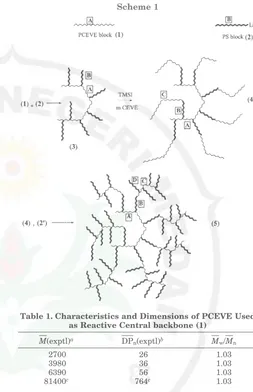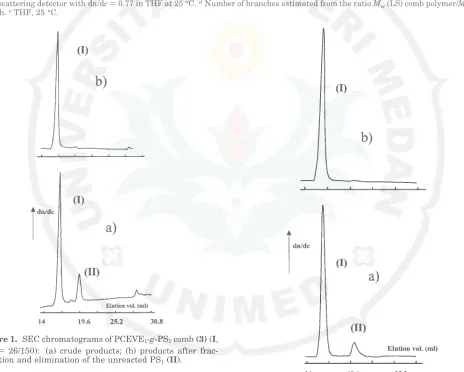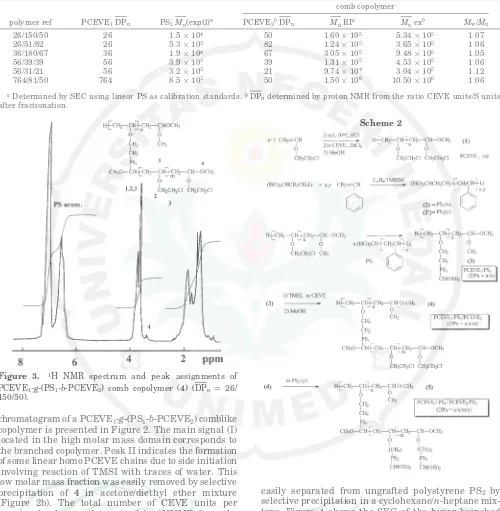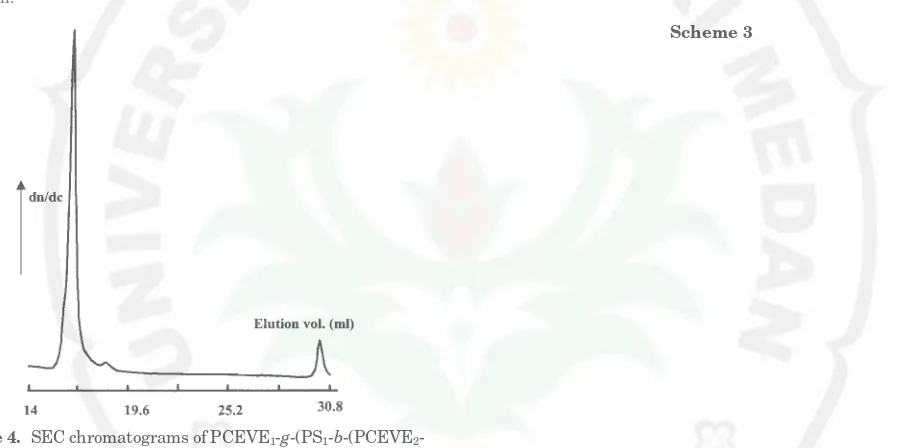Articles
Hyperbranched Nanomolecules: Regular Polystyrene Dendrigrafts
Zainuddin Muchtar, Michel Schappacher, and Alain Deffieux*
Laboratoire de Chimie des Polyme`res Organiques, UMR 5629 CNRS-ENSCPB, Universite´Bordeaux 1, 16 Avenue Pey Berland, 33607 Pessac, France
Received March 12, 2001; Revised Manuscript Received June 26, 2001
ABSTRACT: Arborescent graft polystyrenes were prepared by the “graft on graft” technique, involving the iterative grafting of end-functional polymer chains onto reactive polymer backbones. The grafts and the reactive backbone building blocks were synthesized individually by living polymerization techniques. The first-generation comb polymers were obtained by the coupling reaction of livingR-acetal polystyryl-lithium onto poly(chloroethyl vinyl ether) PCEVE chains of controlled DPn. Initiation from acetal termini of polystyrene branches of a new living cationic polymerization of chloroethyl vinyl ether (CEVE) allowed one to prepare the corresponding comb copolymers with polystyrene-b-poly(chloroethyl vinyl ether) branches. Hyperbranched polystyrenes were finally obtained by grafting a second amount of polystyryl-lithium onto the CEVE units of poly(CEVE) external blocks. Nanomolecules of narrow molar masses distribution, branching functionalities up to 35 000, and molar masses over 108g/mol were obtained by this method. By varying DPnof the different elementary building blocks, various polystyrene dendri-grafts were prepared, demonstrating the possibility to control the core-shell parameters of these macromolecular objects. The solution properties and the characteristic chain parameters ([η],Rg,Rh,) of the hyper-branched polystyrene macromolecules were determined and compared with literature data.
Introduction
In addition to the various random branching reactions that may affect chain architecture in noncontrolled polymerizations, synthetic methods allowing the prepa-ration of specifically highly branched macromolecules have been recently developed.1-8Architectures with a
single polyfunctional branching point (star polymers) containing arms of the same or different chemical compositions, structures with a given number of branch-ing points distributed randomly or uniformly along a backbone chain (graft and comb polymers),9-11 and
macromolecules possessing regularly distributed “tree-like” or “dendritic” branching points12-17(usually called
dendrimers) have been prepared and studied, thus covering a broad domain from weakly branched to highly branched architectures.
We have recently reported a new method for the synthesis of monodisperse polystyrene stars and combs with well-controlled chain characteristics (backbone dimensions and architecture and number and size of branches). The method is based on the highly selective coupling of living polystyryllithium onto poly(chloroethyl vinyl ether) chains; both the PS grafts and the poly-(CEVE) building blocks were prepared individually by living polymerizations.9-11A similar strategy was very recently applied to the preparation of novel star poly-mers with four and five comb polystyrene branches.12
The synthesis of arborescent graft polymers with a dendritic-like architecture, i.e., “dendrigrafts”, using this approach could be of considerable interest since these macromolecules can be obtained in a few steps with a good control of the different structural parameters (number and position of branching points, elementary
polymer segment length). Moreover, such nanometric objects could cover the gap in size between dendrimers and polymer particles.
This paper describes the synthesis of regular PS dendrigrafts from first generation stars and/or comblike polystyrenes and their structural characteristics as well as some of their solution properties.
Experimental Section
Materials. Benzene and toluene (99.5%, J. T. Baker, Deventer, The Netherlands) were purified by distillation over calcium hydride and stored over polystyryllithium seeds. R-Chloroethyl vinyl ether (CEVE) (99%, Sigma-Aldrich Chimie, Saint Quentin Fallavier, France) was washed with an aqueous NaOH solution (1 N) and distilled twice over calcium hy-dride. Styrene (99%, Sigma-Aldrich Chimie, Saint Quentin Fallavier, France) was purified by distillation over calcium hydride at reduced pressure.N,N,N′,N′- Tetramethylethylene-diamine (TMEDA) (99.5%, Sigma-Aldrich Chimie, Saint Quentin Fallavier, France) was dried and purified by distil-lation over sodium.sec-Butyllithium (1.3 M in cyclohexane, Sigma-Aldrich Chimie, Saint Quentin Fallavier, France) was used as received.
HCl gas (99.9% Setic Labo, Versailles, France) was used as received. Zinc chloride (99.999% Sigma-Aldrich Chimie, Saint Quentin Fallavier, France) was dissolved in dry diethyl ether (7×10-3mol L-1).
All the reactants were stored under dry nitrogen in glass apparatus fitted with PTFE stopcocks.
Techniques.Because of the high molar masses difference, separation between the graft copolymers (combs and dendri-grafts) and unreacted PS was directly achieved by selective precipitation of the graft structures into a mixture of cyclo-hexane/heptane (50/50, v/v). In the same way, separation of the comb copolymers (PCEVE1-g-(PS1-b-PCEVE2) and a small
fraction of linear PCEVE, formed by side initiation involving residual HI, was achieved by selective precipitation of the comb copolymer into diethyl ether/acetone mixture.
SEC measurements were performed in THF at 25 °C (flow rate 0.7 mL/mn) on a Varian apparatus equipped with refrac-tive index (Varian) and laser light scattering (Wyatt technol-ogy) dual detection and fitted with four TSK gel HXL columns (250, 1500, 104, and 105Å). Calibration in the case of refractive index detection was performed using linear polystyrene or linear poly(CEVE). For light scattering detection, the dn/dc values of the graft copolymers were determined separately for each type of sample, in THF, with a laser source operating at 633 nm.
1H NMR spectra were recorded on a BRUKER AC 200 MHz
in CDCl3. The DPnof the poly(CEVE2) branches of the comb backbone precursor (PCEVE1-g-(PS1-b-PCEVE2) was deter-mined by1H NMR from the integration ratio between the units belonging to PS1and those of PCEVE blocks considering that the contribution of the central PCEVE1backbone is negligible in comparison to the PCEVE2blocks.
Dynamic light scattering measurements were performed on a MALVERN apparatus (Zetasizer 3000 HS) equipped with a He-Ne laser source (633 nm). Correlation functions were analyzed by the Contin method. Latex particles were used as calibration standards.
Intrinsic viscosities were measured in THF at 25 °C with an automatized Ubbelohde viscometer (SemaTech).
Polymerization Procedures. (a) Synthesis of the PS Building Blocks.The anionic synthesis of polystyryllithium chains using 3-lithiopropionaldehyde diethyl acetal as initiator has been already described.12
(b) Preparation of the Poly(CEVE) (PCEVE) Building Blocks.For the synthesis of PCEVE1(1) used as the central backbone,R-chloro(2-chloroethyl) ethyl ether, the HCl-CEVE adduct, was used as the chain precursor. Its synthesis and the CEVE polymerization have been already described.9
The synthesis of the PCEVE2blocks, forming the multi-branched reactive backbone in PCEVE1-g-(PS1-b-PCEVE2) combs is illustrated in the following example. PCEVE1-g-PS1 comb (3) with DPn(PCEVE))56 and DP(nPS branch))39 (20.0 g, 9.7×10-5mol) is placed in a glass reactor fitted with PTFE stopcocks and dissolved in 50 mL of dry toluene. To remove traces of moisture, the solvent was evaporated under vacuum and the polymer was vacuum-dried for 5 h at 60 °C. The operation was repeated twice. The polymer was then redis-solved into anhydrous toluene (100 mL) and CEVE (27.0 g, 25.4×10-2mol) was added under nitrogen. The reactor was thermostated at-35 °C and TMSI (1 mL, 7×10-3mol) added to convert acetal end groups of3intoR-iodoether ones. After 1 h of stirring at-35 °C, a ZnCl2solution (1 mL, 3×10-3g of ZnCl2/mL of diethyl ether) was added to initiate the CEVE polymerization and the conversion was followed by SEC analysis of aliquots of the reaction medium. At the end of the polymerization (10 h), a lutidine/methanol solution (10 mL, 1 mol/L) was added to deactivate the polymerization system.
The crude polymer solution was then washed several times with a solution of potassium thiosulfate (50 mL, 2/100 weight) and neutral water.4was finally recovered by solvent evapora-tion under vacuum and characterized (yield 40.5 g, Mhn(RI)) 1.3×105g/mol,{Mhw}/{Mhn})1.06).
(c) Grafting Reactions onto Poly(CEVE).The prepara-tion of PCEVE1-g-PS1comb structures by termination of PSLi chains onto chloro functions of CEVE units of PCEVE homo-polymer as already been described.10
Preparation of polystyrene dendrigrafts from PCEVE1-g -(PS1-b-PCEVE2) combs. A solution of polystyryllithium (8 g PSLi,Mhn)1590) in benzene (100 mL) was placed in a buret and incrementally added under dry nitrogen atmosphere to comb PCEVE1-g-(PS1-b-PCEVE2) (respectively DPn56/39/39, 1 g, 2.2×10-6mol,Mhn)453 000), previously degassed under vacuum and dissolved in dry benzene (20 mL). The rate of PSLi addition was determined by the disappearance of the coloration of the PCEVE solution. PSLi was added until a fading pink color of the reacting media remained over about a 24 h period.
Deactivation of residual PSLi was finally achieved by adding degassed methanol (1 mL). Yield)5.5 g,Mhn(SEC))3.3×105, Mhn(LS))2.5×106, andMhw/Mhn)1.1.
Results and Discussion
The general approach to the synthesis of PS dendri-grafts is described in Scheme 1. The strategy consists of grafting living polystyryllithium chains (2,2′) onto
poly(chloroethyl vinyl ether) chains (PCEVE) of con-trolled DPn. Polystyryllithium grafts were prepared in
benzene in the presence of a equimolar amount of tetramethyl ethylenediamine (TMEDA), using propyl-lithium diethylacetal as the initiating system.12PCEVE1
homopolymers (1) were prepared as previously described
by living cationic polymerization and were used as precursors for the preparation of first generation branched macromolecules (Scheme 2). The grafting reaction of anionic PSLi chains was performed by adding the living carbanionic solutions onto a known quantity of PCEVE, until a persistent light-red coloration of the medium remained.
The high selectivity of the reaction between carban-ionic chain ends and chloroethyl ether groups has been recently demonstrated in the synthesis of series of poly-(chloroethyl vinyl ether)-g-polystyrene stars9as well as
Scheme 1
Table 1. Characteristics and Dimensions of PCEVE Used as Reactive Central backbone (1)
M(exptl)a DPn(exptl)b Mw/Mn
2700 26 1.03
3980 36 1.03
6390 56 1.03
81400c 764c 1.03
aApparent peak molar mass determined by SEC using linear
polystyrene standards.bDetermined by proton NMR from the
ratio CEVE/terminal acetal.cDetermined by SEC using linear
of both linear and cyclic comb copolymers.10 High
efficiency in the substitution reaction of chloride was used to get starlike and comblike polymers with a uniform number of branches.9
In the present work, this methodology was first applied to the synthesis of regular branched comblike polystyrenes having a controlled number of ω
-acetal-PS branches of same length attached to a linear PCEVE1backbone, see Table 1. The SEC chromatogram
of a typical crude poly(chloroethyl vinyl ether)-g -polystyrene graft copolymer (DPn(PCEVE))26,MnPSgraft
) 150) is presented in Figure 1. The main signal (I), located in the high molar mass domain, corresponds to the graft copolymer. Population II, withMnidentical to that of the initial PSLi, corresponds to the excess of PSLi added. This fraction was easily removed by selective precipitation of I into cyclohexane/hexane mixtures. The characteristics of the corresponding PCEVE1-g-PS1graft
copolymers (3) are collected in Table 2. The theoretical
molar masses of the graft copolymers calculated from
the molar mass of the PCEVE1 backbone and that of
the PS1graft, assuming one graft per CEVE unit, closely
fit with experimental molar masses determined by SEC using light scattering detection. Data confirm that grafting is quantitative with respect to the chloroether functions.
Preparation of PCEVE1-g-(PS1-b-PCEVE2) Comb
Copolymers (4).The living/controlled character of the
cationic chloroethyl vinyl ether polymerization was further used to grow PCEVE blocks from the macro-molecular chain precursor (3). Initiation of the CEVE
polymerization from the acetal end of polystyrene branches was performed as previously described by adding to the branched macromolecular precursor solu-tion successively trimethylsilyl iodide (TMSI), the mono-mer, and zinc chloride as catalyst.19 A typical SEC Table 2. Characteristics of PCEVE1-g-PS1Comblike Polymers
PSLi1 comb polymer
comb ref PCEVE1DPn Mn(exptl)a M
n(theor)b MnRIa MwLSc Mhw/Mhn hfd η(dL/g)e 26/150 26 1.52×104 3.95
×105 1.27×105 4.00×105 1.07 25 0.19
26/51 26 5.30×103 1.40×105 6.00×104 1.64×105 1.06 30 0.12 36/180 36 1.92×104 6.93
×105 1.93×105 7.22×105 1.05 36 0.20
56/39 56 3.93×103 2.20×105 7.11×104 2.07×105 1.06 53
56/31 56 3.22×103 1.80×105 5.50×104 1.62×105 1.15 51 0.09 764/81 764 8.50×103 6.50×106 9.90×105 5.80×106 1.06 637 0.46
aDetermined by SEC using linear PS as calibration standards.bCalculated from DP
nPCEVE1xMnPS1.cDetermined by SEC using light scattering detector with dn/dc)0.77 in THF at 25 °C.dNumber of branches estimated from the ratioM
w(LS) comb polymer/MnPS branch.eTHF, 25 °C.
Figure 1. SEC chromatograms of PCEVE1-g-PS1comb(3)(I, DPn ) 26/150): (a) crude products; (b) products after frac-tionation and elimination of the unreacted PS1(II).
chromatogram of a PCEVE1-g-(PS1-b-PCEVE2) comblike
copolymer is presented in Figure 2. The main signal (I) located in the high molar mass domain corresponds to the branched copolymer. Peak II indicates the formation of some linear homo PCEVE chains due to side initiation involving reaction of TMSI with traces of water. This low molar mass fraction was easily removed by selective precipitation of 4 in acetone/diethyl ether mixture
(Figure 2b). The total number of CEVE units per macromolecule was determined by 1HNMR from the
relative integrals of CEVE units/styrene units of the precursor (3), Figure 3. We have shown in a previous
study that CEVE initiation from acetal chain termini is a quantitative reaction.12 The comb molar mass
increase, as determined by SEC using light scattering detection, and the narrow dispersity of the branched block copolymers (Ipe1.1) are in good agreement with an homogeneous growth of PCEVE blocks at almost each polystyrene branch end and support the good control of the grafting from process. The dimensional characteristics of the corresponding PCEVE1-g-(PS1-b
-PCEVE2) comb copolymers (4) are collected in Table 3.
Polystyrene Dendrigrafts (5). Their preparation
was finally achieved by grafting PSLi chains (2′) onto
the PCEVE1-g-(PS1-b-PCEVE2) combs (4), Scheme 2. As
previously indicated, due to the large difference in their molar masses, the hyper-ramified structure could be
easily separated from ungrafted polystyrene PS2 by
selective precipitation in a cyclohexane/n-heptane mix-ture. Figure 4 shows the SEC of the hyper-branched copolymer obtained from PCEVE1-g-(PS1-b-PCEVE2)
with blocks of respective DP, 26/150/50 and final PS2
graft of DPn)50. The peak is unimodal and remains
quite narrow (e1.1) which is consistent with a clean and homogeneous grafting process.
The dimensional and solution characteristics of sev-eral hyper-branched structures are collected in Table 4. The theoretical molar masses of the PS dendrigrafts, calculated from the DPn of the poly(CEVE) backbone
(4) and theMnof the PS2graft, assuming one graft per
CEVE unit, agree with the experimental molar masses determined by SEC using light scattering detection, and the molar masses distributions remain narrow (Mw/Mn
< 1.3) for each dendrigraft. Molar masses up to 100 million were measured for these polymers of the second generation.
Table 3. Characteristics of PCEVE1-g-(PS1-b-PCEVE2) Comblike Copolymers
comb copolymer polymer ref PCEVE1DPn PS1Mn(exptl)a PCEVE2bDPn M
nRIa Mnexb Mhw/Mhn
26/150/50 26 1.5×104 50 1.60
×105 5.34×105 1.07
26/51/82 26 5.3×103 82 1.24×105 3.65×105 1.06
36/180/67 36 1.9×104 67 3.05
×105 9.48×105 1.05
56/39/39 56 3.9×103 39 1.31×105 4.53×105 1.06
56/31/21 56 3.2×103 21 9.74×104 3.04×105 1.12
764/81/50 764 8.5×103 50 1.50×106 10.50×106 1.06
aDetermined by SEC using linear PS as calibration standards.bDPndetermined by proton NMR from the ratio CEVE units/S units after fractionation.
Figure 3. 1H NMR spectrum and peak assignments of
PCEVE1-g-(PS1-b-PCEVE2) comb copolymer (4) (DPn ) 26/ 150/50).
By treating the logarithm of radius of gyration against the logarithm of experimental weight average molar mass, it is found that its size (Rg) fits approximately
the relationRg∝Mνwithν)0.35, Figure 5. This value of the exponent is consistent with the theoretical predic-tion of De Gennes and Harvet21(
ν)0.2-0.3) and Murat
and Grest22(ν)0.33) for classical dendrimers. These results suggest that most of the hyperbranched poly-mers have a spherical shape. However, when examining more carefully data for samples in the lower molar mass
range, the agreement is questionable. This can be explained by the complex chain architecture of these macromolecular objects which is characterized, in ad-dition to the molar mass, by four independent chain parameters corresponding successively to the dimen-sions of the PCEVE backbone, the first PS graft, the second PCEVE block and the final PS graft. Change in one of these parameters yield different families of hyperbranched polymers for which k and νcan differ
in the equation Rg ) kMν. Moreover, experimental evidences, obtained in the solution and in the bulk, respectively, by neutron scattering23 and AFM,24
show that depending on the main backbone length (PCEVE1) the shape of the nanomolecules may vary
from spherical to cylindrical. This last topology is clearly observed for the sample with a PCEVE backbone of DPn)764.
Indeed, regarding the different chain building param-eters, it is believed that the DPnof the PCEVE
back-bone that determine the number of first PS grafts will contribute to the shape of the object which can then varies from spherical to rodlike.24The first generation
of PS branches can be considered mostly as a spacer bearing the second-generation building blocks constitut-ing the shell of the object. DPn of the outer PCEVE
blocks will determine the potential number of external PS grafts per branch and therefore will contribute to the shell thickness. This last parameter is also deter-mined by the molar mass of the outer PS graft. In the different reported examples, Table 4, this last block
Table 4. Characteristics of PCEVE1-g-(PS1-b-(PCEVE2-g-PS2)) Dendrigrafts
dendrigraft RI detectora LS detectora samples DPnof
elementary blocks Mhn(exptl)PS2 a
Mhn(theor)b (g/mol) M
hn(exptl) (g/mol) M
hw(exptl) (g/mol) M
hn(exptl)
(g/mol) (nm)Rg [η] c
(dL/g) (nm)Rh Rη d
(nm) (g/cmd 3) 26/150/50/50 5440 7.7×106 7.0×105 5.8×106 5.0×106 30.5 0.26 28 27 0.12 26/51/82/50 5400 11.0×106 3.1×105 9.6×106 9.4×106 27.3 0.13 21 27 0.19 36/180/67/37 3800 7.9×106 7.2×105 7.3×106 6.9×106 29 0.25 27 30 0.11 56/39/39/15 1590 3.5×106 3.3
×105 2.7×106 2.5×106 18 17
56/31/21/45 4700 5.7×106 6.7×105 5.2×106 5.0×106 27 0.12 21 0.22 764/81/50/39 4060 1.5×108 3.1×106 1.3×108 1.2×108 77.5 0.19 60 71 0.13
aMhnandMhwdetermined by SEC using refractive index (RI) or light scattering (LS) detectors; dn/dc)0.177 in THF at 25 °C.bMhn
Calculated from DPnPCEVE1[MnPS1+(DPnPCEVE2×MnPS2)].cViscosity measured inTHF at 25 °C.dCalculated from the Einstein equation.
Figure 4. SEC chromatograms of PCEVE1-g-(PS1-b-(PCEVE2 -g-PS2)) dendrigraft (5) (DPn)26/150/50/50) after elimination of the excess PS2by selective reprecipitation.
Figure 5. Double logarithmic variation of Rg with the experimental molar mass of PCEVE1-g-(PS1-b-(PCEVE2 -g-PS2)) dendrigrafts.
represents more than 95% percent of the total mass of the unimolecular particle.
Viscosity measurements performed in THF and cyclo-hexane confirms that the PS dendrigrafts behave as compact nondraining spheres or cylinders, as previously reported for other hyperbranched polystyrene struc-ture.18-20 Intrinsic viscosities are lowered by about a factor 102in comparison with linear polystyrene of same
molar mass. Indeed, no noticeable solvent effect on the particle dimensions is observed when going from good to a Θ solvent. Interestingly, the viscosity and the
dimensions of the particles, the viscosimetric radius (Rη) and the hydrodynamic radius (Rh) are significantly
affected by the length of the PS1blocks. For dendrigrafts
of about the same molar mass, the higher the PS1 DPn,
the higher the viscosity and the dimensions of the particle. For example, sample 26/150/50/50 (Mw expLS
)5.8 106g/mol), exhibits [η], R
ηand Rhabout two times higher than the 26/51/82/50 sample of higher molar mass (Mw expLS ) 9.8 106 g/mol). This is consistent
with a strong extension of the PS1 segments, thus
yielding to the formation of an empty space inside the particle, see Scheme 3. Monomer unit density in the particles in solution was estimated from their gyration radius and molar masses. In a good solvent, calculation indicates that the number of styrene units by arbitrary volume unit is approximately 200 times higher than that for linear polymers yet 3-4 times higher than that for polystyrene combs, in agreement with the high compactness of these unimolecular particles; see Table 5.
In conclusion, a new strategy for the synthesis in a few steps of unimolecular nanoparticles based on cova-lent assembly of elementary macromolecular blocks has been developed. The possibility to adjust the structure and dimensions of the different building elements all prepared by living polymerization techniques allows a good control of the size, shape, compactness and func-tionality of the final objects. This opens interesting
possibilities in tuning their properties for specific ap-plications such as host-guest interactions in the pres-ence of organic molecules.
Functionalization of the particle surface by hydro-philic groups and their impact on the solubility and solution properties of the dendrigrafts will be reported in a forthcoming publication.
References and Notes
(1) Branched Polymers I and II. InAdvances in Polymer Science; Roovers, J., Vol. Ed.; Springer-Verlag: Berlin 1999; Vols. 142 and 143.
(2) Star and hyperbranched Polymers. InPlastics Engineering Series; Mishra, M. K., Kobayashi, S., Eds.: Marcel Decker, Inc.: New York 1999; Vol.53.
(3) Hempenius, M. A.; Michelberger, W.; Moller, M. Macromol-ecules1997,30, 5602, 17.
(4) Roovers, J. Encycl. Polym. Sci. Eng.1985,2, 478.
(5) Tomalia, D. A.; Naylor, A. M.; Goddard, W. A.Angew. Chem. Int. Ed. Engl.1990,29, 138.
(6) Mourey, T. H.; Turner, S. R.; Rubinstein, M.; Frechet, J. M. J.; Hawker, C. J.; Wooley, K. L.Macromolecules1992,25, 2401.
(7) Voit, B.J. Polym. Sci., Part A: Polym.Chem.2000,38, 2505. (8) Haag, R.Chem. Eur. J.2001,7, 327.
(9) Deffieux, A.; Schappacher, M.Macromolecules1999,32, 1797. (10) Schappacher, M.; Billaud, C.; Paulo, C.; Deffieux, A.
Makro-mol. Chem. Phys.1999,200, 2377.
(11) Schappacher, M.; Deffieux, A.Makromol. Chem. Phys.1997,
198, 3953.
(12) Deffieux, A.; Schappacher, M.Macromol. Symp.1998,132, 45. Schappacher, M.; Deffieux, A.Macromolecules2000,33, 7371.
(13) Choi, S.; Briber, R. M.; Bauer, B.J.; Topp, A.; Gauthier, M.; Tichagwa, L.Macromolecules1999,32, 7879. 18.
(14) Gauthier, M.; Moller, M.Macromolecules1991,24, 4548. (15) Gauthier, M.; Tichagwa, L.; Downey, J. S.; Gao, S.
Macro-molecules1996,29, 519.: Choi, S.; Briber, R. M.; Bauer, B. J.; Liu; D.; Gauthier, M.Macromolecules2000,33, 6495. (16) Sheiko, S. S.; Gauthier, M.; Moller, M.Macromolecules1997,
30, 2343.
(17) Choi, S.; Briber, R. M.; Bauer, B. J.; Topp, A.; Gauthier, M.; Tichagwa, L.Macromolecules1996,29, 519.
(18) Wintermantel, M.; Gerle, M.; Fischer, K.; Schmidt, M.; Wataoka, I.; Urakawa, K.; Tsukahara, Y.Macromolecules
1996,29, 978.
(19) Schappacher, M.; Deffieux, A., Haucourt, N., Goethals, E. Makromol. Chem. Rapid.Commun.1992,13, 329. (20) Striolo, J. M.; Praunitz, J. M.; Bertucco, A.; Kee, R. A.;
Gauthier, M.Polymer2001,42, 2579.
(21) De Gennes; P.-G.; Hervet, H.J. Phys.Lett.1983,44, L351. (22) Murat, M.; Grest, G. S.Macromolecules1996,29, 1278. (23) Borsali, R.; Lecommandoux S.; Schappacher, M.; Deffieux,
A. Manuscript in preparation.
(24) Viville, P.; Deffieux, A.; Schappacher, M.; Bredas, J. L.; Lazzaroni, R.Macromol. Symp.2001,167, 243.
MA010429Q
Table 5. Comparison of the Radius of Gyration〈Rg〉and the Density of Linear, Comb, and Dendrigraft Polystyrenes in THF Solution at 25°C (Molar Mass of the
Polymer: 7×106g/mol)
linear PSa PS comb PS dendrigraft
〈Rg〉(nm) 133.8 34.2 25 density (g/cm3) 1.2
×10-3 6.9×10-2 1.8×10-1



